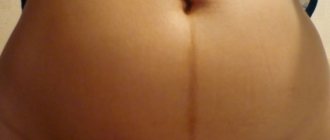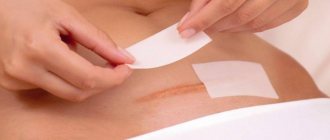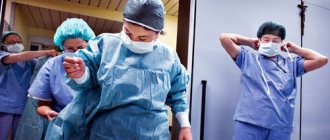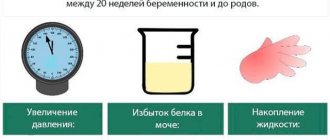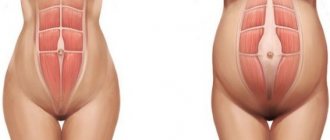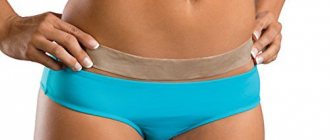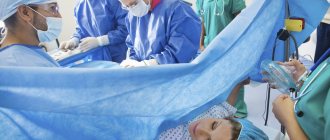Pain occurs not only during childbirth, but also after cesarean section. The suture after a cesarean section hurts on the skin and on the uterus, and the pain from uterine contractions also bothers me. All this causes unpleasant emotions and can have a bad effect on the postpartum recovery of the body.
Sometimes the pain after a cesarean section is much worse than the pain during childbirth. Since every 3-4 women have to deal with this operation, the question of how much the stomach will hurt worries many expectant mothers.
Cause of pain in the suture area
Even before giving birth, I always explain to patients the main cause of pain - the incision itself. Any wound, until it heals, aches and causes discomfort. And as a result of CS, several lesions remain at once, because the first layer of skin on the abdomen is cut directly, followed by the muscles and walls of the uterus. Therefore, it is quite natural that painful sensations last a long time and declare themselves quite loudly.
Why the suture hurts after a cesarean section can also be caused by:
- Increased sensitivity of damaged tissues. Everyone's pain threshold is different, and sometimes even a simple cut on the finger can be painful for a long period. What can we say about the situation when a large area of skin and tissue of internal organs is deeply damaged. If I see that a woman in labor is having a hard time with postoperative pain, I prescribe gentle painkillers that are harmless and safe even during the feeding period.
- Poor elasticity of the postoperative scar. If the scar tissue is not elastic enough, severe pain occurs when the abdominal muscles are tense. As a rule, the problem completely disappears only 4–6 months after the CS.
- Problems that have arisen in the functioning of the intestines. Flatulence is one of the problems that arise as a result of surgery. Which is understandable - the integrity of the abdominal tissues is disrupted during the CS process, causing disruptions in the gastrointestinal tract. Gases accumulate, which are the “culprits” of tingling and aching pain in the peri-suture area. To reduce such manifestations, the woman in labor is prescribed compositions that stabilize intestinal motility.
- Adhesive process. The formation of internal adhesions is a common phenomenon that occurs as a result of dissection of the abdominal wall and damage to internal organs and tissues. With the developing adhesive process, discomfort is inevitable. It can continue for up to several months in a row.
- Contracting uterus. The process of uterine involution occurs especially rapidly in the first days after birth and can last several months. The painful sensations that accompany it can also be strong at the very beginning and gradually subside.
The exact cause of pain can only be determined by fully examining the patient and studying the accompanying symptoms.
Postoperative problems
Some patients encounter this problem: the suture oozes after a caesarean section.
This phenomenon is considered a consequence of some pathology. If the patient notices ichor oozing from the wound, the doctor should be informed immediately. Only a specialist will help determine the cause of bleeding and choose the right method to eliminate the problem.
Pathology should not be ignored. This can lead to worsening of the problem and additional surgical intervention.
Operation characteristics
Caesarean section is one of the safest ways to give birth to a child. The operation is prescribed for medical reasons. Surgical intervention allows you to avoid the death of a child during natural childbirth. The operation is also recommended for patients whose children require postpartum medical care.
During a caesarean section, several types of tissue are cut. During surgery, the doctor penetrates the muscle frame through the abdominal cavity. The abdominal muscles gently move apart. The specialist gains access to the uterus. The wall of the uterus is dissected with a transverse incision in the suprapubic part. Through the resulting incision, the baby and placenta are removed. The stitches are applied in reverse order.
Initially, the doctor fastens the walls of the uterine cavity with a soluble thread or special metal staples. The specialist places the muscles above the surface of the seam. If the muscle tissue was damaged during cesarean section, stitches are also applied. The incision in the peritoneum is sutured with surgical thread, which must be removed after the incision has healed.
In some cases, during a cesarean section, it is necessary to make a longitudinal incision. Such intervention is carried out rarely and only when there is an urgent need. This form of wound allows the surgeon to gain access not only to the uterus and baby, but also to the chest organs. With this operation, the seams are rougher. The walls of all organs are stitched with self-absorbing material.
After the operation, the doctor gives a number of recommendations to the patient. She must strictly follow all advice. This will help the stitches heal faster. But the recovery period does not always go smoothly. Some patients complain that the suture oozes after a caesarean section.
Causes of wound dehiscence
The seam begins to ooze for various reasons. The following factors can interfere with the healing process:
- development of infectious pathology in the wound;
- postoperative hematoma;
- excessive physical activity of the patient;
- use of self-dissolving threads.
In many cases, the problem occurs due to the development of infection in the wound. The pathogenic microorganism enters the wound cavity when the sutures are treated incorrectly or untimely. The pathogenic microorganism begins to actively multiply and causes inflammation.
The inflammatory process is accompanied by an increase in leukocytes in the blood. White blood cells perform a protective function. Leukocytes capture dead tissue. Leukocytes, cerebrospinal fluid and tissue cells accumulate in the infected field.
The liquid increases in volume and begins to release to the surface. The stitches are starting to ooze.
The reason may also be the presence of a postoperative hematoma. A hematoma is characterized by the accumulation of blood in the subcutaneous layer. The liquid is dark in color due to the accumulation of red blood cells.
The hematoma disappears on its own in most women. In rare cases, hematoma fluid causes inflammation of the walls of the resulting cavity. Inflammation is accompanied by the release of fluid from the wound.
In this case, the ichor has a brown color.
A common reason why stitches begin to ooze is excessive physical activity of a young mother. After a cesarean section, experts do not recommend moving during the first three days. During this time, the tissues take the desired position. The woman completely recovers from the effects of the anesthetic.
On the fourth day, you are allowed to move around the ward and perform some manipulations with the baby. But not all patients listen to doctors' advice. Early physical activity leads to partial divergence of the sutures. An ichor emerges from the wound.
Continued failure to comply will result in additional surgery.
A rare cause of suture dehiscence is the use of inappropriate surgical material. If a self-dissolving thread was used to hold the edges of the wound together, healing occurs slowly. But such a problem is a medical error.
The problem often occurs in women who are overweight. After a caesarean section, a drainage tube is inserted to drain fluid from the peritoneum. The liquid is collected in a special disposable container.
With a large body weight, the drainage may spontaneously fall out. Ichor begins to ooze from the open wound. If drainage has been rejected, you should inform your doctor.
He will install a new tube and secure it with two side sutures.
Warning signs
In order to promptly prevent the seam from coming apart, you need to carefully monitor your well-being and the condition of the seam. The following unpleasant symptoms should cause alarm:
- pain in the incision area;
- the appearance of a large amount of ichor a few days after the operation;
- swelling of the tissue around the suture;
- redness of the edges of the wound;
- increased body temperature;
- changes in the characteristics of vaginal secretions.
Normally, the sutures may hurt for no more than a week after a cesarean section. The intensity of the symptom gradually decreases. The pain recedes. An alarming sign of the development of a pathological process is increased pain a few days after a cesarean section. An increase in pain should be accompanied by a visit to the doctor.
After a caesarean section, a small amount of ichor may be released from the wound for several days. The volume of liquid gradually decreases. After a few days, the napkin remains dry. But sometimes there is a sharp increase in fluid secretion.
The transparent substance that oozes from the wound is yellow in color. In some cases, the ichor contains an admixture of blood. If a woman notices such a change, she should inform the observing specialist.
He will examine the seams and determine the cause of the fluid.
A sign of infection is tissue swelling and redness. Edema is caused by a latent inflammatory process. It can be determined by palpating the peri-wound surface.
The swollen tissue is hard to the touch and lacks elasticity. After a cesarean section, swelling may be present in the first three days. It should disappear over time.
Increased swelling indicates the presence of any pathologies.
It is also necessary to monitor your general well-being. If the suture does not bleed much, the patient may not pay attention to it. Every day, the treatment nurse distributes thermometers to measure temperatures. Inflammation is accompanied by a slight increase in temperature.
In the presence of pathology, an increase in indicators to 37.5 degrees is observed. If the process intensifies, the temperature can rise to 39 degrees. In order to promptly detect the development of pathology, all results obtained are entered into the patient’s chart.
Using them, the doctor can track the characteristics of a woman’s recovery after a caesarean section.
The seam may not ooze immediately. In this case, it is recommended to monitor the characteristics of vaginal secretion. After a cesarean section, the uterus begins to be cleansed of lochia accumulation. They stand out in large volume and are red in color.
Such discharge can last up to 21 days. Alarm should be caused by changes such as: the appearance of a sharp unpleasant odor, a change in the volume of discharge, impurities of pus or ichor. Such changes indicate the development of infection in the wound.
In this case, it is necessary to urgently visit the treatment room.
Methods of combating pathology
If the suture is oozing, the doctor must determine the exact cause of the problem. Only after this is a way to combat the disease selected.
The following methods are proposed to eliminate the pathological discharge of ichor:
- washing the wound with an antiseptic solution;
- installation of an additional drainage tube;
- drug therapy;
- increasing the amount of dressing.
If the suture is oozing due to infection or improper cleaning of the wound, an antiseptic solution is used. It is injected into an open wound. Flushing is carried out until the liquid is completely clean.
A clear solution should be released from the wound. The procedure is carried out twice a day. This will eliminate pathogens from the wound.
After the seam stops oozing, the edges of the wound are treated with a solution of brilliant green or fucorcin.
If there is a large amount of ichor secreted, additional drainage is required. During the examination, the wound is treated with an antiseptic liquid. The edges are treated with an antibacterial agent. A sterile silicone tube is inserted into the resulting hole, which is attached to the walls with separate sutures.
Fluid will drain freely through the drainage tube. The tube is also used to continuously cleanse the wound of accumulated dead tissue. An antibacterial solution is injected into it. It is also removed through drainage. Processing is carried out until the seam stops oozing.
Only after this can you proceed to normal care.
The wound can become wet under the influence of various factors. To stop the negative process, additional drug therapy is necessary.
Various antibiotic substances are used to destroy pathogens. In a hospital setting, the antibiotic is administered intramuscularly.
This use of the drug allows you to quickly stop the development of the disease and prevent bleeding from the suture.
Many clinics prescribe medications belonging to the group of fluoroquinolones. Such drugs are used to combat a variety of purulent and bacterial infections. It is not recommended to take such medications on your own. Improper use may worsen the disease.
In rare cases, the suture oozes due to internal dehiscence of the wound edges. With this complication, the woman needs additional surgical intervention. Internal bleeding is determined using ultrasound. If there is a large accumulation of fluid in the abdominal cavity, urgent surgery is needed.
After a caesarean section, the patient needs a long and proper recovery. All recommendations must be followed exactly. If a woman does not follow the rules of postoperative care, the suture may ooze. In this case, the recovery period is extended.
Source: //JdemBaby.com/rody/cesarean/sochitsya-shov-posle-kesareva.html
How much does a stitch hurt after a caesarean section?
It is inappropriate to talk about any time frame in this matter. Not a single doctor, including me, can tell you exactly how long the stitch left after a cesarean section will hurt. Here everything depends on the individual health indicators of the mother in labor, as well as many other reasons. Normally, the aching sensation should disappear after a couple of weeks. But if, for example, as a result of surgery, swelling and hematomas remain on the abdomen, the rehabilitation period may be significantly delayed. Phenomena of this kind arise mainly due to the unprofessionalism of doctors, when during surgical manipulations blood vessels are truncated incorrectly. In such situations, how long the suture will continue to hurt after a cesarean section depends solely on the rate of vascular regeneration. But you shouldn’t expect that the pain will go away in a couple of weeks. In most cases, full recovery requires at least six months.
Does your stitch hurt after a caesarean section?
Not really
The cause of such complications can also be improper dressing, as a result of which the incisions are compressed, resulting in pressure on the fresh wound, which causes discomfort and pain, which can be felt for several months.
We cannot exclude a rather rare, but still sometimes occurring phenomenon - seam divergence, in which the size of the incision increases. It can occur 6-10 days after birth, when the stitches are removed, which causes the discrepancy.
If a woman has a complication such as endometritis, that is, inflammation of the mucous membranes of the uterus, then pain can appear at any time, last a long time and be accompanied by severe pain, bleeding, and high fever.
Possible complications
There are frequent cases of some postoperative complications, which can also cause severe, long-term pain in the suture area. The main cause of these unpleasant sensations is inflammation of the uterus - endometritis. In this situation, in addition to the pain at the suture site, pain also occurs in the pelvic area. In parallel with this, discharge with an unpleasant odor appears, women's temperature increases, and malaise appears. In this case, doctors recommend contacting a specialist and not ignoring these manifestations, as this can lead to serious consequences. In the most severe cases, it can be fatal.
If the seam hurts for a long time: a month, six months
Definitely, no “ifs” should arise in attempts to resolve this issue. There is only one correct way out here.
Important! If a month after a cesarean section or, even worse, after six months, a year, the suture left after the CS begins to bother you, contact your doctor immediately!
The most likely late complications are:
- ligature fistulas;
- hernias;
- keloid scars;
- endometriosis.
They can be associated either with the body’s rejection of the threads used during surgery, or with uneven tissue compaction or inflammation. Only a specialist can find out why the suture from a caesarean section hurts for longer than the permissible time.
Behavior rules
Basically, doctors, if pain or discomfort occurs in a mother who has given birth surgically, prescribe ointments for her, since they have a less detrimental effect on the baby. To speed up the healing process, it is recommended to follow several rules:
- Dressings must be changed promptly. For this event, use only clean gauze, and treat the damaged area with brilliant green for disinfection.
- It is not recommended to remain in bed for a long time. Even if a woman in labor experiences discomfort while walking after a caesarean section, she must find the strength to continue walking.
- After the wound has completely healed, you can resume water treatments, but rubbing the damaged areas with a rough washcloth is not recommended.
- You should not wear clothes that will tighten your body; it is better to give preference to loose cotton fabric.
- A woman needs to monitor her diet. You should avoid foods that promote gas formation; it is better to give preference to those rich in vitamin E, as this vitamin helps accelerate tissue regeneration.
- It is forbidden to lift heavy objects, as the seam may come apart.
- You can begin sexual activity only two to three weeks after a caesarean section.
If you carry out proper care in the first time after surgery, this will significantly reduce the wound healing time. If all recommendations for caring for the suture are followed, it will quickly heal and will not cause discomfort to the patient.
If unusual sensations, severe pain, sharp tingling sensations are detected, as well as if there is pain in the area of the postoperative suture several months after the intervention, you should not hesitate, go to see a doctor and conduct a full examination. After all, if the disease is neglected, it can lead to serious complications, the worst of which is death.
Inner seam hurts
A suture on the uterus after a cesarean section, as well as an external scar, can begin to hurt even after two years, without seemingly any reason. As a rule, this is caused by the beginning of the adhesive process in the pelvic organs. If I suspect this pathology, I always prescribe laparoscopy to the patient. Only this research method makes it possible to visually determine the location of adhesions and dissect them. After this, the woman’s pain completely disappears, and her reproductive functions return to normal. After all, it is the adhesive process that often leads to ectopic pregnancies and, as a consequence, infertility. In addition, seemingly harmless adhesions often cause intestinal obstruction and a number of other complications.
The internal suture after a cesarean section may also come apart, causing severe pain. This happens if a woman in labor does not follow the doctor’s instructions, lifts weights, or resorts to strong physical exertion. Of course, you cannot take any action on your own in such situations. The doctor should clean the wound and prescribe antibacterial drugs.
Duration of pain after surgery
Pain that occurs due to natural causes goes away quickly. Intense sensations subside 7 days after a cesarean section. To reduce pain symptoms on these days, the doctor prescribes analgesics, but the mother often refuses, fearing to harm the baby.
Painful symptoms that arise from tension do not go away quickly. Restoration and healing of damaged tissue occurs 3-4 months after surgery. It is worth noting that the manifestation of unpleasant sensations gradually subsides, approaching the end of the recovery stage.
The uterus, which causes pain in the lower abdomen, stops contracting and returns to normal 3-5 days, maximum a week after the birth of the child.
Prolonged pain that does not stop for a long time is studied by a doctor. Self-medication will lead to complications that will affect the baby.
Today, on average, every 8th pregnant woman undergoes a caesarean section. This operation helped millions of children see the light of day and their mothers experience the joy of motherhood. It is carried out only for indications that threaten the life or health of the pregnant woman or child. This is explained by the fact that the risk of complications during and after delivery increases 12 times compared to physiological childbirth.
During surgical delivery, the woman’s abdomen and uterus are cut open and the newborn is removed. Sutures are placed on the uterus, then all the cut tissues are sewn together in layers. Internal sutures are made with a special suture material, which safely dissolves after 65-80 days. The skin at the incision site is stitched either with silk threads or also with absorbable material. The location and size of the suture in the skin depends on how urgently the operation was performed. If doctors had to operate urgently, saving the lives of the mother and child, then a vertical incision is made from the pubis to the middle of the abdomen. This incision provides more opportunity to access the uterus and quickly remove the baby from the womb.
After being removed from the uterus, the newborn is handed over to neonatologists and then the doctors can slowly take care of the mother - carefully apply all the stitches.
When performing a planned surgical intervention, when the operation is planned in advance for some reason, a transverse incision is made above the pubis. The scar after such an incision is smaller and looks more aesthetically pleasing, especially after a year.
Abdominal pain after a cesarean section is natural during the first month or two after surgery.
When to be wary
I will list the main signs indicating the need to urgently go to the hospital:
- The suture hurts a lot and fluid comes out of it.
- The scar is red and the stomach hurts on palpation.
- Feels very weak.
- Dizziness occurs.
- The temperature has risen.
- There was bleeding.
- Vomiting and nausea are present.
- There is a pulling sensation in the lower abdomen.
- There are problems with urination and defecation.
- The menstrual cycle has become irregular.
All these symptoms indicate that the recovery process is unstable, that is, an infection has entered the body or inflammation has begun in the abdominal organs.
What do doctors think?
“Postoperative sutures will inevitably bother a young mother during the recovery period after childbirth, which took place surgically. But it is important to pay attention to the fact that normally, after a cesarean section, the scar hurts for no more than a month. The pain will be more severe in the first few days and will gradually subside over a few weeks. In addition, they may intensify during breastfeeding, but only during the period of establishing lactation.
If the suture hurts even after two or three months have passed since the day of birth, you need to contact a gynecologist to determine the cause of the ailment. Concomitant symptoms in the form of fever, bleeding, discharge from the suture, etc., no matter what period they appear, should also alert you. Women can avoid almost all serious complications if they monitor their health, listen to doctors’ recommendations and undergo timely examinations,” said obstetrician-gynecologist of the highest category Ruslan Evminov, sharing his opinion on postpartum pain.
Pain in the lower abdomen after surgery
Pain in the lower part after surgery is considered a natural phenomenon. During natural childbirth, contractile movements occur in the uterus for some time, which leads to nagging pain, similar to menstrual pain. The pain symptom intensifies during breastfeeding. During the process, a hormone is produced in the female body that promotes contraction of internal female muscles.
For longer and more persistent discomfort, you should consult a doctor. This symptom may indicate disorders in the uterus, an internal inflammatory process.
Discomfort is caused by the seam. The healing process of tissues after damage is long and always accompanied by unpleasant sensations. Sudden movements, turns, even coughing or sneezing create sharp, fast-passing pain.
The scar's intense sensitivity to stress persists for a week, then subsides. Pharmacies sell a bandage to reduce pain and pressure on the tissue located next to the suture; women in labor are advised to wear it.
As healing progresses, a scar appears on the body, creating a dull and stabbing pain. After a cesarean section, a woman should monitor the healing of the wound and ensure that no inflammation or purulent discharge appears at the incision site.
After abdominal surgery, a mother may complain of abdominal pain due to intestinal dysfunction. Anesthesia is used during surgery. The drugs affect the small and large intestines. As a result, gas formation increases and the motor activity of the tract worsens. Abdominal bloating and delayed bowel movements cause discomfort and pain to the mother in labor.
Lack of bowel movements leads to constipation and a feeling of heaviness in the stomach. To normalize bowel function, a woman must follow a diet. It is possible to prescribe medications that promote rapid excretion of feces and cleanse the intestinal tract.
Unpleasant sensations are caused by the disturbed position of the internal organs. During pregnancy, the uterus, along with the fetus, enlarged and moved apart the organs located inside the abdominal cavity. After a cesarean section and extraction of the fetus, the uterus did not contract and continues to put pressure on the intestines. The stomach, shifting, puts pressure on nearby organs. The process continues for two days, and the location of the insides becomes normal.
Innervation at the incision site
The incision through which the child is taken out means a rupture of nerve connections - innervation. Therefore, for a long time, the young mother feels numbness in the lower abdomen under the stitch. As the nerve connections are restored, the numbness gradually goes away. Nerve endings take much longer to heal and connect than normal tissue. The process takes up to 1 year.
